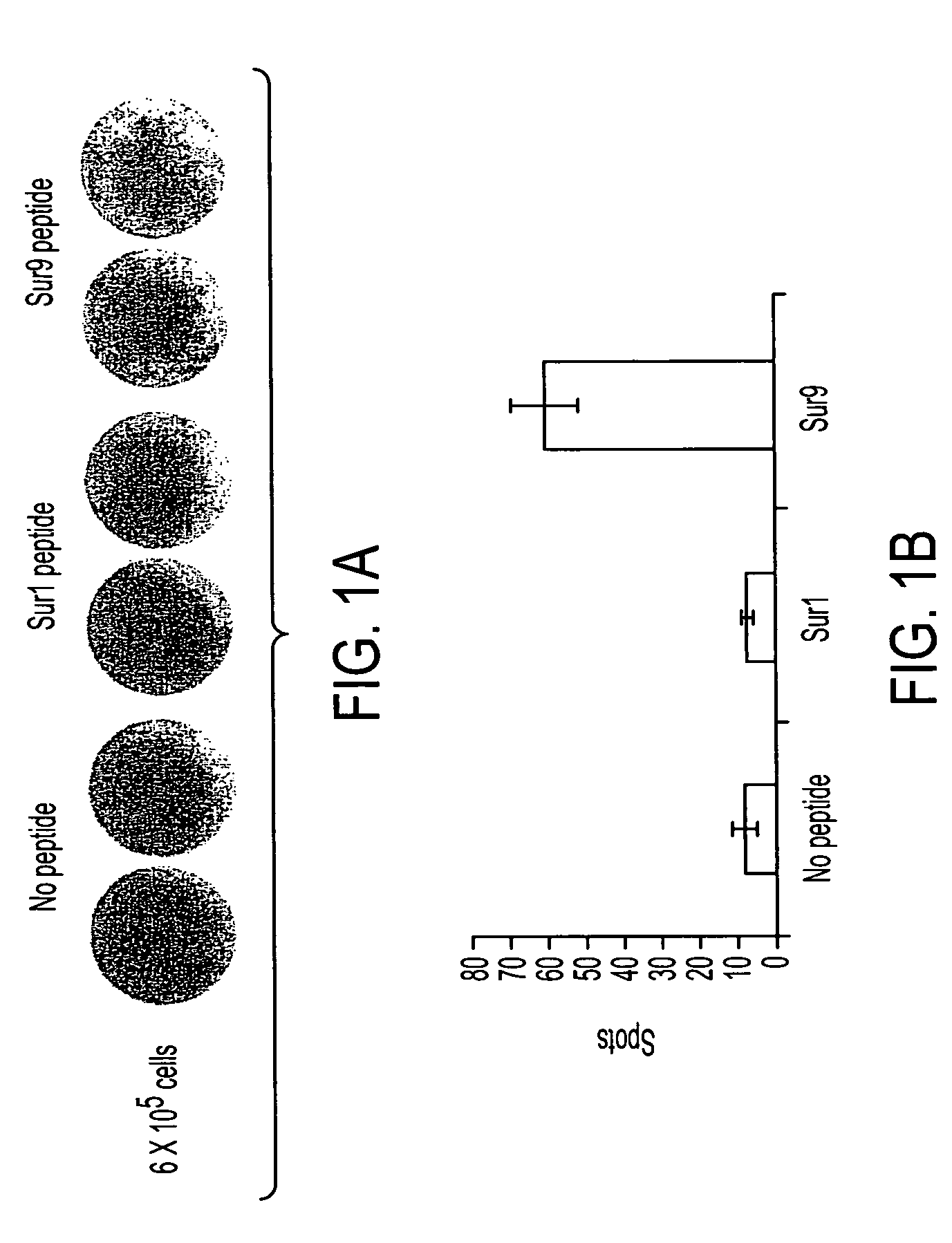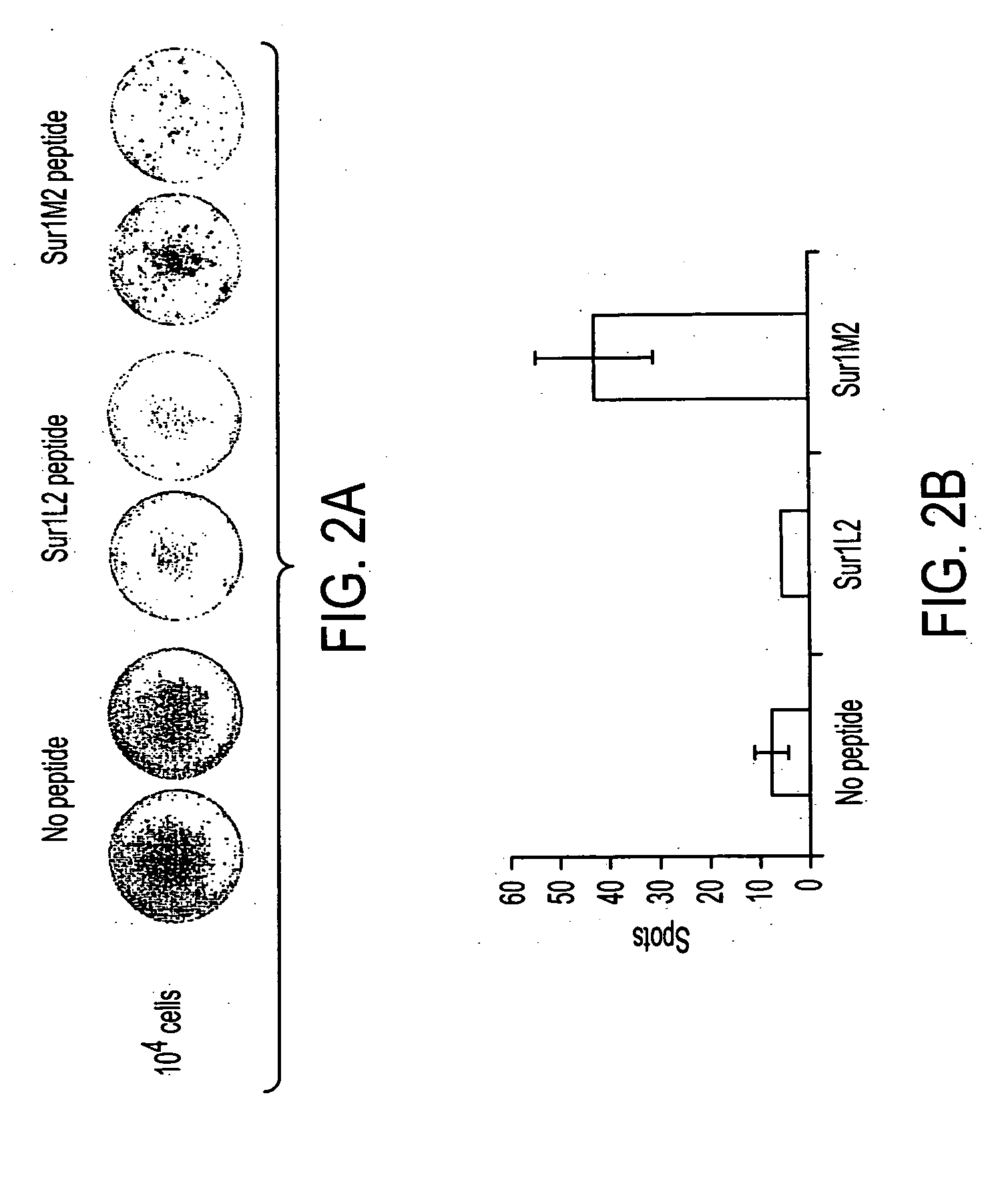Survivin-derived peptides and use thereof
a technology of survivin and peptides, applied in the field of survivin-derived peptides, can solve the problems of unfavourable prognosis of tumours of non-melanocyte origin, peptides cannot be applied to tumours, and the expression of survivin is associated with unfavourable prognosis,
- Summary
- Abstract
- Description
- Claims
- Application Information
AI Technical Summary
Benefits of technology
Problems solved by technology
Method used
Image
Examples
example 1
[0072] Identification of a Cytotoxic T-Lymphocyte Response to the Apoptosis Inhibitor Protein Survivin in Cancer Patients
[0073] Summary
[0074] Using CTL epitopes derived from survivin, specific T-cell reactivity against such antigens in peripheral blood from chronic lymphatic leukemia (CLL) patients and in tumor-infiltrated lymph nodes from melanoma patients by ELISPOT analysis have been studied. CTL responses to survivin derived peptide epitopes were detected in three out of six melanoma patients and in three out of four CLL patients. No T-cell reactivity was detected in PBL from six healthy controls. Thus, survivin derived peptides may serve as important and widely applicable targets for anti-cancer immunotherapeutic strategies.
[0075] Introduction
[0076] The survivin protein was scanned for the presence of HLA-A*0201 (HLA-A2) binding peptide motifs and after successful identification, the peptides were used to test for specific T-cell reactivity in leukemia and melanoma patients by ...
example 2
[0096] Spontaneous Cytotoxic T-Cell Responses to Survivin-Ferived MHC class I-Restricted T-Cell Epitopes in Situ and Ex Vivo in Cancer Patients
[0097] Summary
[0098] Spontaneous cytotoxic T-cell responses to survivin derived MHC class I restricted T-cell epitopes were demonstrated in situ as well as ex vivo in breast cancer, leukemia, and melanoma patients. Moreover, survivin reactive T cells isolated by magnetic beads coated with MHC / peptide complexes were cytotoxic to HLA-matched tumours of different tissue types. Being a universal tumor antigen, survivin may serve as a widely applicable target for anti-cancer immunotherapy.
[0099] Materials and Methods
[0100] Construction of HLA-Peptide Complexes for T-Cell Staining and T-Cell Sorting
[0101] A recognition site for enzymatic biotinylation using biotin protein ligase (BirA) in fusion with the 5'-end of the extracellular domains of HLA A*0201 (residues 1-275) was expressed in E. coli BL21 (DE3). The recombinant protein was purified by si...
example 3
[0115] HLA-B35-Restricted Immune Responses to Survivin Derived Peptides in Cancer Patients
[0116] Summary
[0117] In this study, two survivin derived epitopes, which are restricted to HLA-B35 were identified and characterized. Specific T-cell reactivity against both of these epitopes was present in the peripheral blood from patients with different haematopoietic malignancies and melanoma. Substitutions of the C-terminal anchor residue improved the recognition by tumor infiltrating lymphocytes from melanoma patients. Furthermore, spontaneous cytotoxic T-cell responses to survivin in situ in a primary melanoma lesion was demonstrated. These epitopes extends the applicability of future vaccine strategies based on survivin peptides in relation to malignancies as well as the HLA profile of the patients involved.
[0118] In Examples 1 and 2, HLA-A2 restricted survivin-derived T-cell epitopes were studied. Since HLA-A2 is only expressed in about 30% of the Caucasian population (63), peptide epi...
PUM
| Property | Measurement | Unit |
|---|---|---|
| Molar density | aaaaa | aaaaa |
| Molar density | aaaaa | aaaaa |
| Molar density | aaaaa | aaaaa |
Abstract
Description
Claims
Application Information
 Login to View More
Login to View More - R&D
- Intellectual Property
- Life Sciences
- Materials
- Tech Scout
- Unparalleled Data Quality
- Higher Quality Content
- 60% Fewer Hallucinations
Browse by: Latest US Patents, China's latest patents, Technical Efficacy Thesaurus, Application Domain, Technology Topic, Popular Technical Reports.
© 2025 PatSnap. All rights reserved.Legal|Privacy policy|Modern Slavery Act Transparency Statement|Sitemap|About US| Contact US: help@patsnap.com



